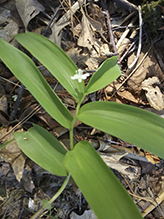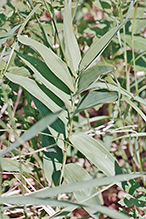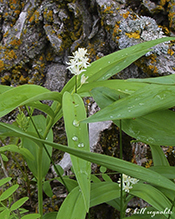starry false Solomon’s seal
(Maianthemum stellatum)
Conservation • Wetland • Description • Habitat • Ecology • Use • Distribution • Taxonomy
Description |
Starry false Solomon’s seal is an 8″ to 24″ tall, erect, perennial forb that rises on a single stem from a long, creeping rhizome. It often forms colonies. The stems are erect, usually slightly reclined, unbranched, slightly zigzagged, and hairless. It has 8 to 11 leaves. The leaves are alternate, spreading to ascending, stiff, usually folded, stalkless, and somewhat clasping. They are lance-shaped, 2⅓″ to 6″ long, and ¾″ to 2″ wide. They are rounded at the base and taper gradually to a point at the tip with straight sides along the tip. The upper surface is hairless, the lower surface finely hairy. The margins are untoothed. The inflorescence is a spike-like, erect or ascending, ¾″ to 2″ long, unbranched cluster of 6 to 15 flowers on a short stalk at the end of the stem. The flowers are about ⅓″ wide and star-shaped. There are 3 narrow, spreading, white petals and 3 similar sepals (6 tepals), and 6 stamens. They have a mild fragrance. The fruit is a globular berry, 5 ⁄16″ to ⅜″ in diameter, with 1 or 2 seeds. It is initially green, becoming dark blue-violet when it ripens. They are yellowish-green when young with 3 to 6 red to purple stripes. When they mature they turn dark red. |
Height |
8″ to 24″ |
Flower Color |
White |
Similar Species |
Common false Solomon’s seal (Maianthemum racemosum var. racemosum) is a slightly taller plant, reaching up to 30″ at maturity. The leaves are broader, egg-shaped to elliptic, and are not stiff or folded. The inflorescence is a plume-like, branched panicle of 20 to 80 tiny flowers. The flowers are about ⅛″ wide. The fruits are smaller and are green with copper spots when young. Hairy Solomon’s seal (Polygonatum pubescens) is a taller plant, reaching up to 36″ at maturity. The stem is arching. The leaves are broader, are on short stalks, and are not stiff or folded. The inflorescence is small clusters of cylinder-shaped flowers hanging downward from most leaf axils. The fruits are green when young and dark blue-violet when mature. Large-flowered bellwort (Uvularia grandifloria) leaves are perfoliate. The inflorescence is 1 to 3 solitary flowers that appear to hang downward from leaf axils. The flowers are bell-shaped, 1″ to 2″ long, and bright yellow. The fruit is a 3-celled, greenish to yellowish-brown capsule. Rose twisted-stalk (Streptopus lanceolatus var. longipes) is a taller plant, reaching up to 36″ at maturity. The stem is hairy, branching, and jointed at the leaf axils giving it a zigzag appearance. The leaves do not clasp the stem. The flowers are dark rose-purple to pink and bell-shaped. They hang downward from leaf axils singly on stems up to 2″ long that are twisted or have an abrupt bend in the middle. The fruit is bright red. Smooth Solomon’s seal (Polygonatum biflorum var. commutatum) is a much taller plant, reaching up to 48″ at maturity. The stem is arching. The leaves are broader and are not stiff or folded. The inflorescence is small clusters of cylinder-shaped flowers hanging downward from most leaf axils. The fruits are green when young and blackish red when mature. |
Habitat |
Dry to moderate moisture. Woods, prairies. Full to partial sun. |
Ecology |
Flowering |
May to June |
Pests and Diseases |
|
Use |
|
Distribution |
||
|
Sources |
|
| 5/25/2025 | ||
Nativity |
||
Native |
||
Occurrence |
||
Common |
||
Taxonomy |
|
Kingdom |
|
Division |
Tracheophyta (Vascular Plants) |
Subdivision |
Spermatophytina (Seed Plants) |
Class |
Liliopsida (Monocots) |
Order |
Asparagales (Agaves, Orchids, Irises, and Allies) |
Family |
Asparagaceae (agave and allies) |
Subfamily |
Nolinoideae (dragon tree) |
Tribe |
Polygonateae (true and false Solomon‘s seals) |
Genus |
Maianthemum (mayflowers and false Solomon‘s seals) |
Subordinate Taxa |
|
|
|
Synonyms |
|
Convallaria stellata Smilacina sessilifolia Smilacina stellata Smilacina stellata var. crassa Smilacina stellata var. mollis Smilacina stellata var. sessilifolia Smilacina stellata var. sylvatica Unifolium liliaceum Unifolium sessilifolium Unifolium stellatum Vagnera liliacea Vagnera sessilifolia Vagnera stellata |
|
Common Names |
|
false Solomon’s seal little false Solomon’s seal starry false lily of the valley starry false Solomon’s seal starry false Solomon’s-seal starry Solomon’s-seal star-flowered false Solomon’s-seal star-flowered lily-of-the-valley |
|
Glossary
Axil
The upper angle where the leaf stalk meets the stem.
Clasping
Describing a leaf that wholly or partly surrounds the stem but does not fuse at the base.
Panicle
A pyramidal inflorescence with a main stem and branches. Flowers on the lower, longer branches mature earlier than those on the shorter, upper ones.
Perfoliate
A leaf having margins that entirely surround the stem, giving the appearance that the stem is growing through the leaf.
Rhizome
A horizontal, usually underground stem. It serves as a reproductive structure, producing roots below and shoots above at the nodes.
Sepal
An outer floral leaf, usually green but sometimes colored, at the base of a flower.
Tepal
Refers to both the petals and the sepals of a flower when they are similar in appearance and difficult to tell apart. Tepals are common in lilies and tulips.
Visitor Photos |
||
Share your photo of this plant. |
||
This button not working for you? |
||
Luciearl |
||
 |
||
 |
 |
|
 |
 |
|
Bill Reynolds |
||
 |
 |
|
MinnesotaSeasons.com Photos |
||
 |
 |
|
Plant |
||
|
||
|
||
|
Plant |
|
 |
 |
|
Inflorescence |
Infructescence |

Visitor Videos |
||
Share your video of this plant. |
||
This button not working for you? |
||
|
Other Videos |
||
Star flowered false Solomon's seal (Maianthemum stellatum) |
About
Jun 19, 2020 Native herb identification in the Pacific Northwest |
Starry False Solomon's Seal (Maianthemum stellatum) |
About
Sep 23, 2015 Found on Vallee-Lourdes Drive, Bathurst, NB, Canada FLOWER: Spike-like raceme 1 to 4 inches long of up to 20 stalked white flowers. Each flower is about 3/8 inch across, has 6 tepals (petals) and 6 stamens with pale yellow or cream-colored tips. LEAVES: Leaves are up to 6 inches long and 2 inches across, generally elliptical tapering to a point at the tip, toothless, finely hairy on the underside, with prominent parallel veins and often folded some lengthwise. The base of the leaf clasps the stem. The stem slightly zig-zags between the alternately attached leaves and may be hairless or finely hairy. The plant does not grow upright but tilts to one side and arcs a bit at the top. FRUIT: Each flower is replaced by a berry, about ¼ inch in diameter. Berries are initially green with purple stripes and ripen to solid reddish-purple. Native in my area, and throughout North America, but again, DO NOT EAT THE BERRIES. Leaves and stems are also poisonous and can leave you feeling rather ill. NOTES: Just looking at the leaves, Smooth Solomon's Seal, False Solomon's Seal, and Starry False Solomon's Seal are all similar. False Solomon's Seal prefers shadier habitats, has more, smaller flowers, plus its leaves do not clasp the stem and are wider than Starry False Solomon's Seal. Smooth Solomon's Seal has racemes of flowers on the underside of the arcing stem, rather than a cluster at the end. Starry False Solomon's Seal often goes by Latin name Smilacina stellata but the accepted name in Minnesota is Maianthemum stellatum. Formerly in the Liliaceae (Lily) family, all Maianthemum species have been reassigned to Ruscaceae (Butcher's Broom). |
Wild Plants in the Garden: Starry Solomon's Seal (Maianthemum stellatum) |
About
May 14, 2022 This is a great way to have access to wild medicinal plants that are, perhaps, less plentiful than those such as Dandelion or Yarrow. |

Visitor Sightings |
||
Report a sighting of this plant. |
||
This button not working for you? |
||
Luciearl |
Location: Cass County |
 |
| Luciearl 6/5/2017 |
Location: Cass County |
 |
| Bill Reynolds 8/25/2015 |
Location: Pennington Co. |
 |
MinnesotaSeasons.com Sightings |
||
Avon Hills Forest SNA, North Unit Forestville/Mystery Cave State Park Hardscrabble Woods / MG Tusler Sanctuary Kellogg Weaver Dunes SNA, Kellogg Weaver Unit Mary Schmidt Crawford Woods SNA Minnesota Valley NWR, Louisville Swamp Unit Mound Spring Prairie SNA, North Unit P.N. and G.M. Nelson Wildlife Sanctuary Robert Ney Memorial Park Reserve |

Created: 6/1/2014 Last Updated: © MinnesotaSeasons.com. All rights reserved. |



